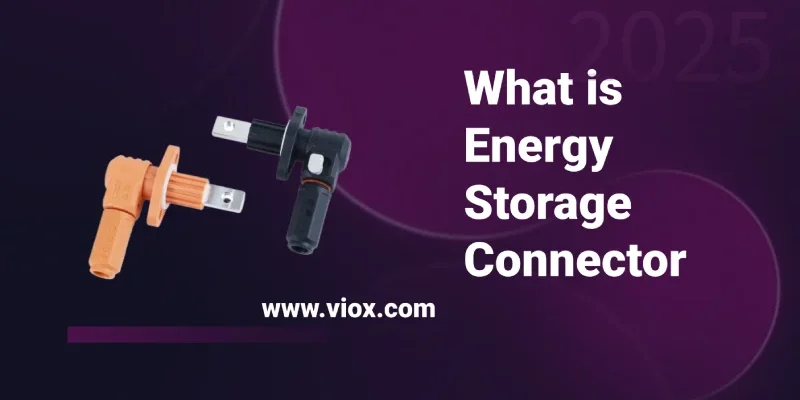Los conectores de almacenamiento de energía son componentes eléctricos especializados diseñados para conectar y desconectar baterías dentro de sistemas de almacenamiento de energía, y desempeñan un papel crucial a la hora de facilitar una transferencia de energía segura y eficiente en aplicaciones que van desde el almacenamiento de energía doméstico hasta proyectos de energías renovables a gran escala.
Características principales de los conectores de almacenamiento de energía
Diseñados para soportar condiciones exigentes, estos conectores cuentan con una serie de características avanzadas que garantizan la fiabilidad y la seguridad:
- Alta tensión y capacidad de corriente: Diseñados para soportar tensiones de hasta 1500 V y corrientes de 100 A a más de 350 A, son ideales para sistemas de energía de alto rendimiento.
- Mejoras de seguridad: Los mecanismos integrados, como la protección contra inversión de polaridad y los sistemas de bloqueo, evitan las desconexiones accidentales y los cortocircuitos, protegiendo tanto a los usuarios como a los equipos.
- Durabilidad medioambiental: Gracias a su resistencia a temperaturas extremas (de -40 °C a 125 °C), vibraciones y golpes, mantienen su funcionalidad incluso en entornos difíciles.
- Mantenimiento mínimo: Características como la ausencia de requisitos de cableado y la alta resistencia del aislamiento (por ejemplo, 5000MΩ) reducen la necesidad de un mantenimiento frecuente al tiempo que garantizan un rendimiento a largo plazo.
Tipos de conectores de almacenamiento de energía
Los sistemas de almacenamiento de energía emplean varios tipos de conectores, cada uno diseñado para aplicaciones específicas:
- Conectores de polos de batería: Facilitan las conexiones rápidas entre módulos de baterías individuales, lo que permite un mantenimiento sencillo y la ampliación del sistema en sistemas de almacenamiento de energía en baterías (BESS).
- Conectores de barra colectora de cobre: Proporcionan soluciones sólidas para conectar varias baterías, mejorando la capacidad total y la potencia de salida en instalaciones más grandes.
- Conectores rápidos: Ofrecen capacidades de montaje y desmontaje rápidas, ideales para sistemas modulares y aplicaciones de energías renovables.
- Conectores de comunicación multinúcleo impermeables: Disponibles en especificaciones de 8, 12 y 24 núcleos, estos conectores con certificación TUV garantizan una transmisión de datos fiable con protección IP67.
Materiales para conectores de energía
Los conectores de almacenamiento de energía se fabrican con materiales de alto rendimiento para garantizar la durabilidad, conductividad y seguridad en entornos eléctricos exigentes:
- Componentes conductores: Las aleaciones de cobre y aluminio se utilizan habitualmente por su excelente conductividad eléctrica. Algunos conectores incorporan contactos de cobre plateados para mejorar aún más la conductividad y reducir la corrosión.
- Aislamiento y vivienda: Los polímeros de alta calidad, como la PA66 (poliamida) y los termoplásticos, se emplean por sus excelentes propiedades de aislamiento, resistencia a las llamas (clasificación UL 94V-0) y durabilidad. Estos materiales también ofrecen protección contra los factores medioambientales.
- Elementos de sellado: El caucho de silicona se utiliza a menudo para el sellado con el fin de alcanzar el grado de impermeabilidad IP67 cuando se acoplan los conectores, lo que garantiza la fiabilidad en diversas condiciones climáticas.
La combinación de estos materiales da como resultado conectores capaces de soportar altas temperaturas, ofrecer un excelente rendimiento eléctrico y mantener la seguridad en aplicaciones de almacenamiento de energía.
Normas del conector energético
Los conectores de almacenamiento de energía deben cumplir estrictas normas industriales para garantizar la seguridad, fiabilidad e interoperabilidad. Entre las principales normas figuran:
- IEC 62109-1: Esboza los requisitos generales de seguridad para convertidores de potencia en sistemas fotovoltaicos, aplicables a los conectores ESS.
- IEEE 1547: cubre las normas de interconexión de los recursos distribuidos con los sistemas de energía eléctrica, incluido el almacenamiento de energía.
- UL 1973: Aborda los requisitos de seguridad para módulos de baterías y conectores en aplicaciones estacionarias.
- UL 1741: se centra en las normas de seguridad para inversores, convertidores y equipos de interconexión utilizados con recursos energéticos distribuidos.
Estas normas garantizan que los conectores de almacenamiento de energía cumplan rigurosos criterios de seguridad, rendimiento y compatibilidad en diversas aplicaciones del sector del almacenamiento de energía, en rápida evolución.
Aplicaciones en sistemas energéticos
Los conectores de almacenamiento de energía se utilizan de forma generalizada en diversos sistemas energéticos, mejorando la eficiencia y la fiabilidad:
- Almacenamiento de energía en el hogar: Estos conectores integran baterías con inversores, lo que permite el autoconsumo efectivo de energía renovable en entornos residenciales.
- Almacenamiento de energía comercial: Facilitan la conexión de grandes sistemas de baterías a la infraestructura de red, apoyando sofisticadas estrategias de gestión energética para las empresas.
- Integración de las energías renovables: Al conectar las baterías a los paneles solares y las turbinas eólicas, estos conectores desempeñan un papel crucial en el almacenamiento de la energía generada para su uso posterior, mejorando la fiabilidad general de las fuentes de energía renovables.


